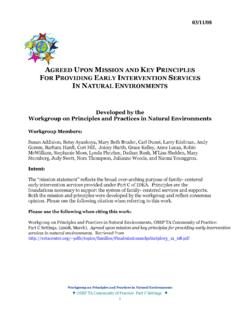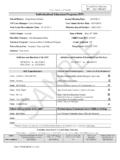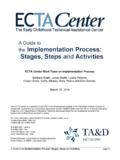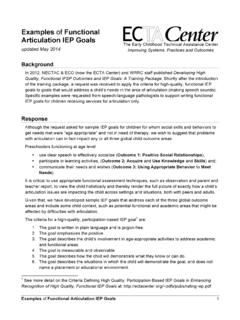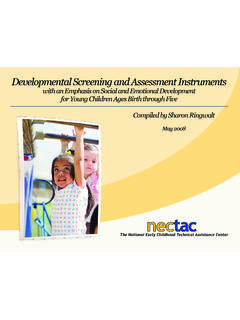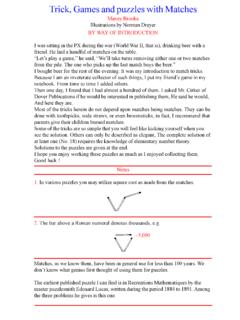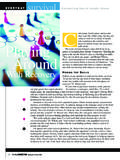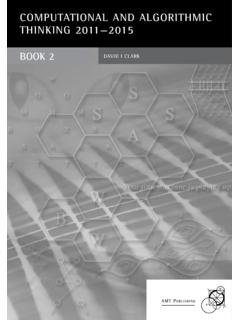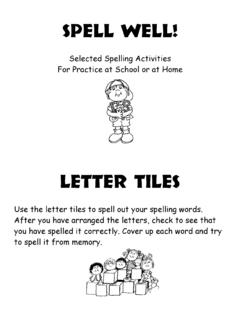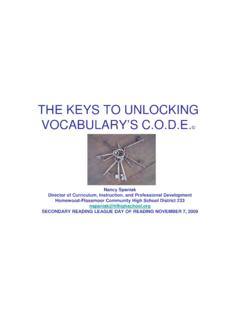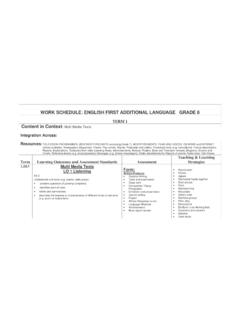Transcription of The Carolina Curriculum for Infants and Toddlers with ...
1 CCITSN Crosswalk - 7-26-09 Note: This is a preliminary draft developed by the Early Childhood Outcomes Center. We are still in the process of refining and revising this document which means that some of the categorizations could change based on additional discussion. We welcome your feedback to 1 Summary Information: The Carolina Curriculum for Infants and Toddlers with Special Needs, Third Edition (CCITSN; 2004) Publisher Brookes Publishing Website for information Cost $ for Curriculum ; $ for package of 10 assessment logs that include the developmental progress chart; $ for downloadable printable masters of assessment logs; $ for master forms on CD (CD includes infant / toddler and preschool forms).
2 Age range Birth 36 months Purpose The CCITSN is a systematic Curriculum that directly links a skills assessment with activities to promote those skills that have not been mastered. Areas included Personal-Social Cognition Communication Fine Motor Gross Motor Time to administer 60-90 minutes. It can be split into two or more sessions Scored Yes. Approximate age-based levels of development in each domain are suggested based on the pattern of credit received on items in the Curriculum sequence in the developmental progress chart Age norms No Age ranges given for items Yes. Age levels are estimates based on information from standardized instruments and the literature on infant and toddler development.
3 How frequently it can be given Flexible Standardized tasks No. Assessment guidelines include general assessment procedures to elicit each skill if it is not observed during the informal observation period at the beginning of the assessment Based on observation in natural settings Yes. Informal observation and directed assessment CCITSN Crosswalk - 7-26-09 Note: This is a preliminary draft developed by the Early Childhood Outcomes Center. We are still in the process of refining and revising this document which means that some of the categorizations could change based on additional discussion. We welcome your feedback to 2 Summary Information (continued): The Carolina Curriculum for Infants and Toddlers with Special Needs, Third Edition (CCITSN; 2004) Instructions related to parent role Parent informally interacts with the child during the observation period.
4 When directed assessment is needed, the parent can be instructed to try particular activities with the child at the assessor s discretion. Parents are asked about the child s skills when observation and directed assessment does not elicit behaviors from the child Data provided on reliability Not available Data provided on validity Not available Web-based data entry Not available Electronic scoring Not available Other languages Assessment log and developmental progress chart available in Spanish Who administers Not specified. People with minimal experience and education in child development can understand and follow the instructions for assessing the skill each item represents and for engaging in activities to promote the development of that skill Training available through the publisher Yes.
5 See CCITSN Crosswalk - 7-26-09 Note: This is a preliminary draft developed by the Early Childhood Outcomes Center. We are still in the process of refining and revising this document which means that some of the categorizations could change based on additional discussion. We welcome your feedback to 3 The Carolina Curriculum for Infants and Toddlers with Special Needs, Third Edition (CCITSN): Crosswalk to Child Outcomes Outcome 1: Has positive social relationships Outcome 2: Acquires and uses skills and knowledge Outcome 3: Takes appropriate action to meet needs Personal-Social 2. Interpersonal Skills a-bb. Smiles reciprocally, participates in simple games, approaches peer or adult to initiate play, works collaboratively toward a goal with peers, etc.
6 3. Self-Concept a-t. Responds to name, plays with mirror image, expresses feelings (4 or more types), performs for others, shows pride in achievements, shows guilt or shame over accidents or prohibited behavior, etc. Communication 14. Conversation Skills a-ll. Smiles to person who is talking and/or gesturing, laughs, waits for adult to take a turn, plays reciprocal games, greets familiar people with an appropriate vocalization or sign, sustains conversation, etc. Personal-Social 3. Self-Concept a-t. Recognizes self and others in mirror, identifies objects as mine , distinguishes and names self in photographs, knows age, tells own first name, answers correctly when asked if he or she is a boy or a girl, etc.
7 Cognition 5. Attention & Memory: Visual/Spatial a-h. Visually fixates for at least 3 seconds, shows anticipation of regularly occurring events in everyday care, retrieves object fully hidden under a cover, reacts to a change in familiar game, retrieves objects from usual locations on request, recognizes the covers of several books and labels them, tells the name of an object or picture shown briefly and shown again in an array of four, etc. 6-II. Visual Perception: Matching & Sorting a-d. Sorts by size, matches primary colors, sorts by shape, sorts by two characteristics, etc. Personal-Social 1. Self-Regulation & Responsibility a-o. Comforts self, entertains self with toys for a short period of time, gets toys to play with from a box or shelf of toys, explores, avoids common dangers, etc.
8 3. Self-Concept a-t. Makes choices, says no or otherwise indicates refusal, resists attempts from others to assist with feedings, identifies objects as mine , competes with peers for toys, asks for snacks or drinks, shows determination/ persistence in choosing or continuing activities, is selective about what tasks he or she will or will not try (recognizes limitations), etc. 4-I. Self-Help: Eating a-z. Smoothly sucks from a nipple, holds own bottle, feeds self with fingers, holds and drinks from a cup, begins to use fork, etc. 4-II. Self-Help: Dressing a-l. Cooperates in dressing and undressing, unties shoes, removes shoes, removes coat, undoes fasteners, etc.
9 CCITSN Crosswalk - 7-26-09 Note: This is a preliminary draft developed by the Early Childhood Outcomes Center. We are still in the process of refining and revising this document which means that some of the categorizations could change based on additional discussion. We welcome your feedback to 4 Outcome 1: Has positive social relationships Outcome 2: Acquires and uses skills and knowledge Outcome 3: Takes appropriate action to meet needs Cognition 7. Functional Use of Objects & Symbolic Play a-r. Explores objects with mouth, combines two objects in a functional manner, pretends that objects are something other than what they are, assumes different roles in fantasy play, etc.
10 8. Problem Solving/Reasoning a-aa. Shifts attention, repeats activities that produce interesting results, looks for or reaches toward objects falling from view, plays with a variety of toys to produce effects, reaches object from behind barrier, solves simple problems without adult assistance, nests containers of graduated sizes, experiments with cause and effect when playing, answers at least one why do question correctly, etc. 9. Number Concepts a-f. Understands more, correctly answers how many for one and two objects Cognition/Communication 10. Concepts/Vocabulary: Receptive a-v. Points to three objects or people on request, follows directions, selects pictures of actions, points to five or more colors on request, selects objects by usage, etc.
